How to implement OKRs: a step-by-step guide

Don´t you how to implement OKRs in your company? Would you like to have a framework that allows everyone in the organization to visualize the business objectives, the key results needed to achieve those objectives and the progress towards them across the entire company? Do you want to know how leadership teams and team leaders can use it to achieve organizational goals? Read on and discover how Triskell Software can help you to implement OKRs in your organization.
OKR: definition and methodology
One of the main consequences of the digital transformation process that all companies are facing in the last decade is the need to deliver products and services to the market in an agile way, providing value to customers and users. To achieve this, it is essential that all members and teams of the organization walk in the same direction, pursuing common objectives and promoting collaborative work in order to obtain the desired results.

STRATEGIC PORTFOLIO MANAGEMENT
Align OKRs with strategy and drive better outcomes
Learn more about Triskell Strategic Portfolio Management solution.
The OKR methodology (Objectives and Key Results) was created by Andy Grove, and then introduced by John Doerr in Google. Now it is a framework used by prestigious companies such as Intel , Cabify or Spotify, allowing, in a simple and structured way, to align all the teams and people in the achievement of Company-level goals. These objectives are measurable through some indicators called ‘Key Results’, which allow monitoring whether or not the proposed objectives are being achieved.
How do the objectives relate to the key results in OKR?
In the OKR methodology, the objectives must have 3-5 key results associated with them that make it possible to assess whether they are being achieved. In other words, while the objectives define the goal towards where the company wants to go, the key results serve to define how the objectives will be achieved, which indicators will be taken as a reference to indicate whether or not it is close to achieving that objective. In addition, each Key Result is accompanied by a series of actions, projects, deliverables, etc., that will facilitate the achievement of that key result.
The objectives set in OKR are annual, although it is recommended that they are reviewed in quarterly cycles, depending on the progress indicated by each of the Key Results, with weekly check-ins if possible. They also can be adjusted or redefined in case the established objective is unambitious or, on the contrary, unattainable. On the other hand, each objective must include at least three “Key Results”, and each Key Result will be associated with a series of initiatives.
An example of how the OKR methodology is structured
The following infographic shows in a visual way how OKR structure would look like in an IT department:
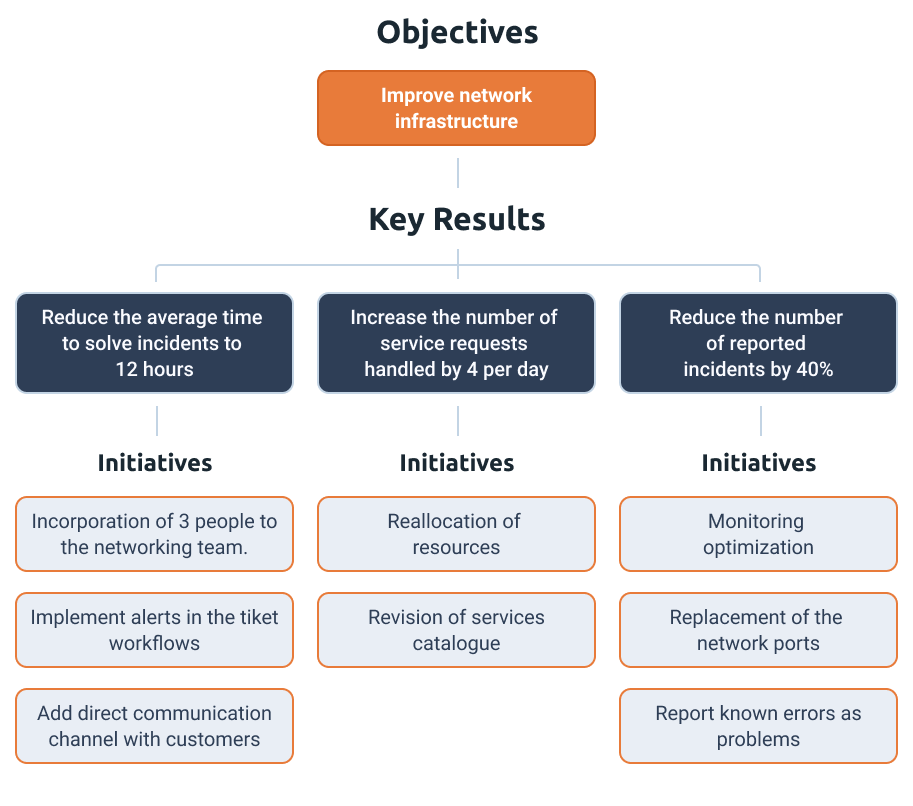
How are objectives scored in OKR?
In most cases, the company OKRs to be set will be annual. However, they should be reviewed periodically, preferably every 3 months, so that you can have a clear view of the progress of the key results and whether or not you are on track to achieve the objectives.
Each employee must rate the objectives and key results on a scale from 0 to 1, with three scales to be taken into account:
- If the average score is below 0.4, then it will be necessary to review whether the objectives are sufficiently realistic, or whether the key results and actions selected are the most appropriate for the achievement of those objectives.
- If the score is 1, it means that you did not set up ambitious goals, so it will be necessary to rethink some objectives again in a way that, without being impossible, involves an effort for the company to achieve them.
- If the average score is between 0.6 and 0.8, it means that you are on the right track to achieving these objectives. Ideally, this should be the average score for companies working with OKRs.
Benefits of OKRs
More and more companies are adhering to the OKR methodology. Whether they are more classic technology companies like Google, Linkedin and Intel, or more growing creations like Spotify and Cabify, the truth is that the methodology is so flexible that it adapts to almost any company and field.
The advantages of OKRs are endless, but they can be summarized in 5 points:
1.Scalable methodology
OKRs can be established at different levels. You can establish Company-Level OKRs, individual team-level OKRs, and even Personal goals, thus creating synergies at all levels of the organization to achieve the objectives that have been set.
2.Agile setting of ambitious objectives
With OKR, team or company managers can quickly set ambitious objectives for the organization. These objectives can be reviewed periodically to make the necessary optimizations in the key results or in the initiatives to be implemented to achieve them.
3. Encourage collaboration
OKR involves all the people and teams that make up the organization in the achievement of the objectives, requiring constant collaboration, performance reviews and communication between the teams to carry out specific actions that lead to the achievement of key results. Silos do not fit in the OKR methodology.
4. Higher productivity
By being very clear about the company’s objectives, all departments and people in the organization know what is really important and adds value to the business. This allows them to focus on those actions and tasks that really help in the achievement of the company strategy, thus increasing the productivity of the workers.
5. Empowerment of company teams and staff
As all departments of the company participate in one way or another in the achievement or not of the objectives, thanks to OKR, employees will feel involved in the success or failure of the business, making them feel motivated to contribute value to the company with their initiatives and actions.
Make OKRs actionable and drive strategic alignment
Request a demo to see firsthand how Triskell’s Strategic Portfolio Management solution can transform your OKR implementation.
How to implement OKRs with Triskell Software
Now that you know what OKR is and all the advantages of this methodology, surely you are already thinking about how its implementation process would look like, right?
However, traditional tools such as the Office package, e-mail or instant messaging applications such as Skype or Teams, or the classic pyramidal communication formulas (annual performance reports, appraisals, etc.), in which managers communicate to their respective employees whether they have met the objectives, are not efficient for a successful implementation of a methodology whose purpose is to promote the alignment and cooperation of all the company’s teams towards common objectives.
Here’s how to implement OKRs in your team and/or organization with Triskell Software:
- Strategic alignment and execution from one single tool.
- Linking initiatives with strategic objectives.
- Workflows and Lifecycles to design your team’s actions.
- Smart Data Analysis for Agile decision making.
- Agile planning of OKRs with Kanban, Roadmap and Masterplan.
- Collaborative tools integrated into Triskell Software.
- Detailed OKR status reporting.
Strategic alignment and execution from one single tool
Most companies fail to meet the objectives they have set. In most cases, this is due to the fact that, when it comes to executing the strategy that has been designed, the teams and people involved in that execution lose focus on the company goals.
This may be because there has been no effective communication of these objectives, because working in silos is still widespread within the organization, or also because, when it comes to implementing the strategy, changes and unforeseen events of all kinds may arise and the previously established strategic planning may be set aside.
For a successful OKR implementation process, it is essential to be able to connect strategic planning with the execution of the initiatives that will help achieve the objectives. And Triskell Software is a flexible tool that allows to align, from a single platform, the organization’s strategy with its execution.
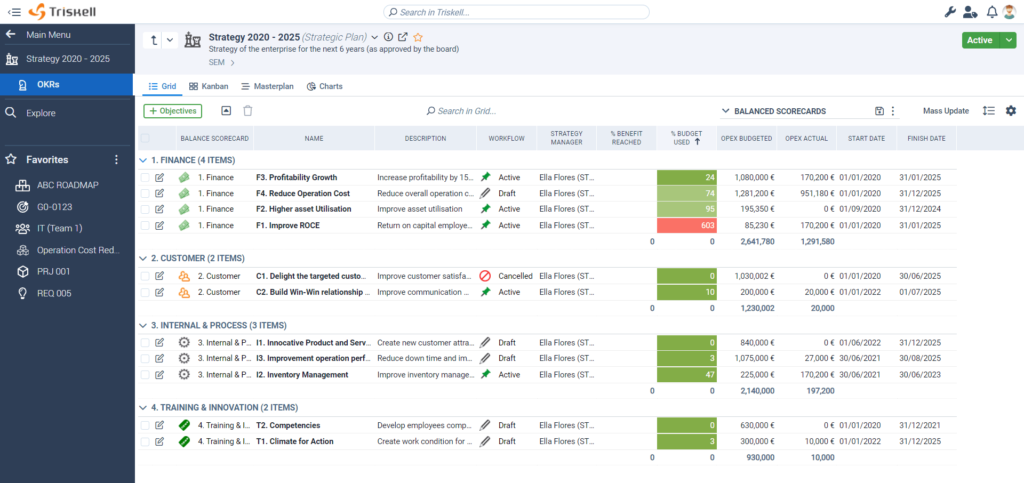
Linking initiatives with strategic objectives
When it comes to achieving the strategic objectives of the organization, its correct execution is essential, with relevant actions and initiatives for each of the key results defined to achieve those objectives. Each of the initiatives that are implemented must be relevant to one of the key results that have been established, and contribute to the achievement, first of all, of that key result, in order to achieve the organization’s objectives.
With Triskell Software you will be able to link each of these initiatives (products, services, campaigns, actions, deliverables, tasks, etc.) with the Key Results, and also with the objectives, thus obtaining a global vision of how the plan is being executed, being able to monitor the progress of each of the key results.
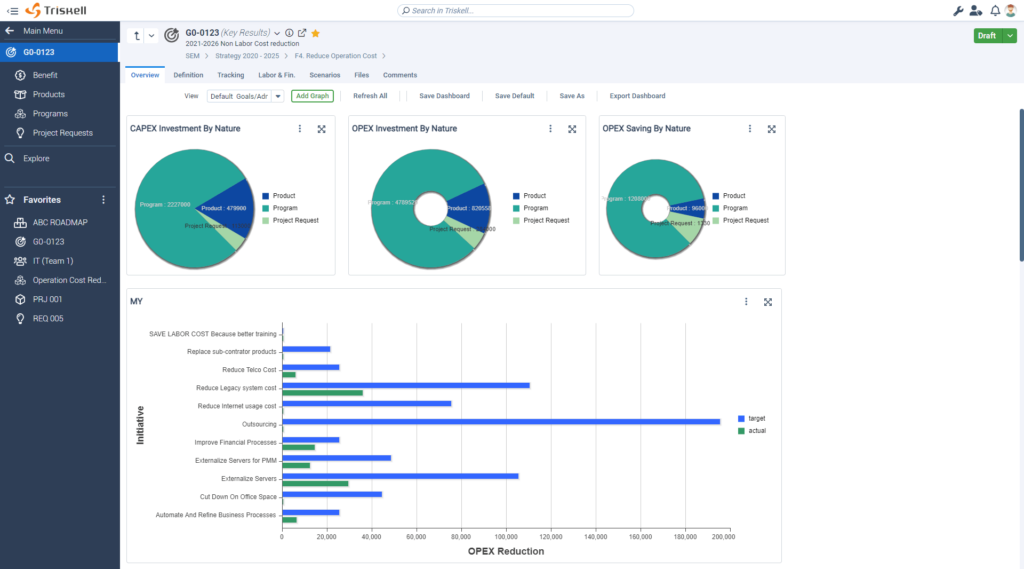
Workflows and Lifecycles to design your team’s actions
An organization without defined processes in its operations, or with certain work areas or people who do not adhere to them, is doomed to fail when it comes to achieving its objectives. It is essential to be able to define clear processes that, at the same time, can be optimized for each of the operations carried out in the organization.
In this sense, Triskell offers the possibility to configure, in a very intuitive and flexible way, workflows and lifecycles for each of the initiatives, projects or products your organization is working on. In this way, it ensures that all the people and teams involved in the OKRs are aligned with the status of the processes to be followed for each of the initiatives.
Smart Data Analysis for Agile decision making
When it comes to the execution of the strategy, teams and organizations often have to deal with unforeseen events that involve reallocating resources or reprioritizing some of the initiatives. It is in these decisions when the people involved in the initiatives lose focus on the objectives and, therefore, the desired goals are not achieved.
Thanks to Triskell’s smart data analysis, any decision-making that has to be made during the execution of the strategy will be based on data and verifiable evidence in real-time, reducing errors when making decisions such as reallocating resources, readjusting budgets or reprioritizing certain initiatives.
WEBINAR
Implementing OKRs with a PPM software
Collaborative tools integrated into Triskell Software
OKRs require active collaboration between the different work areas of the organization to achieve the objectives. Thanks to Triskell Software, you will have a series of collaborative tools with which team members can communicate in real-time and share relevant documentation and information so that everyone is informed of progress.
For example, in Triskell you can add comments and share files in each of the deliverables your team is working on, being able to configure from the same interface an alert system with which all team members are informed and can communicate possible updates in progress.
Agile planning of OKRs with Kanban, Roadmap and Masterplan
In Triskell Software you have several views with which you can visualize Objectives, Key Results initiatives, etc… and obtain relevant information about the status, assigned resources, costs and delivery times in real-time.
The Kanban view will allow you to check and manage, in an agile and visual way, the status of each initiative and its respective workflow. Kanban provides an overview of the status of each initiative, facilitating decision-making and prioritization of tasks and resources. The Kanban view is really easy to use in Triskell. You can filter, sort and change status and values just by moving the cards from one column to another.
Triskell also has Masterplan and Roadmap views. The Masterplan view displays the initiatives and their connections chronologically, which is helpful in identifying and unifying your short and long-term vision, as well as facilitating the prioritization of initiatives or being able to consult their progress.
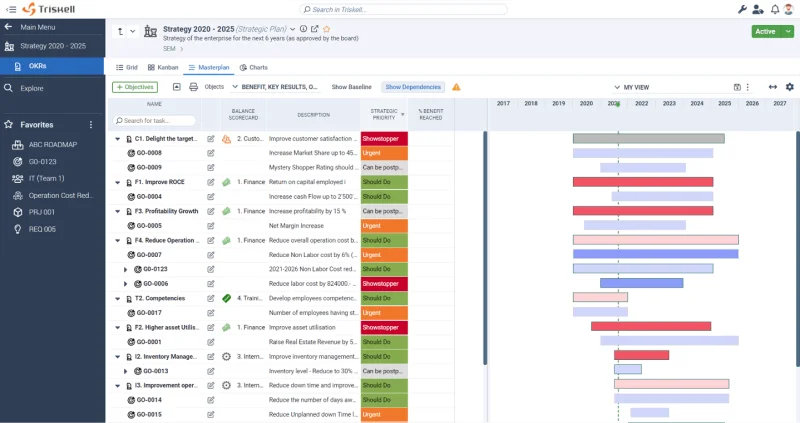
However, the Roadmap view provides an overview of the initiatives that are being carried out to achieve the organization’s objectives, allowing you to understand the priority of each of them and the order in which they should be followed.
Detailed OKR status reporting
Accurate data analysis and interpretation are key for organizations to achieve their goals. In this sense, having tools that allow the design of dashboards adapted to the needs of the organization is essential to understand how the strategy is being executed.
Triskell Software has dashboards in table format with which users can consult all the information in real-time. You can filter, sort and group the information to consult the relevant KPIs of your business to achieve your Objectives and Key Results.
With Triskell you will also be able to automatically aggregate all your KPIs, linking them to each of your Strategic Objectives and Initiatives in order to monitor and share the execution of your business strategy.
SUBSCRIBE TO OUR NEWSLETTER
Get stories like this in your inbox
Request a demo of Triskell Software
Triskell Software is the tool you need to successfully implement OKRs in your organization. Request a demo.
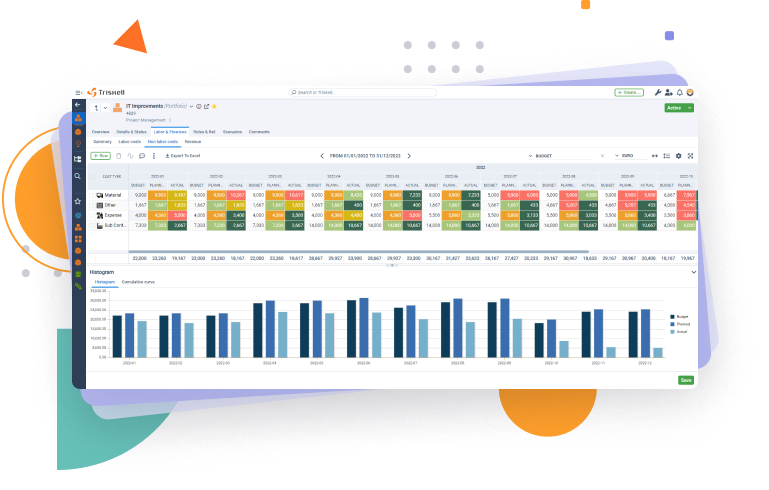
FAQs about how to implement OKRs
What are the key things to consider when defining objectives?
When crafting your objectives, remember they should be ambitious and inspirational. They outline the “what” you want to achieve, not the “how“. Here are some hallmarks of a strong objective for your OKR implementation:
- Qualitative: While objectives should be ambitious, they shouldn’t be overly specific. Instead, focus on the desired outcome and the impact it will have.
- Time-bound: Your objectives should have a clear timeframe, typically aligning with your OKR cycle (e.g., quarterly). This instills a sense of urgency and focus.
- Directional: Objectives should be aspirational, pushing your team to stretch and innovate.
How many key results should each objective have?
There’s no magic number, but aiming for 3 key results per objective is a good rule of thumb. Think of key results as the measurable markers that demonstrate progress towards your objective. Having too many dilutes focus, while too few might not adequately capture the objective’s essence.
What cadence is recommended for tracking OKRs?
Regular check-ins are essential for successful OKR implementation. While the specific frequency may vary depending on your organization, a common cadence is quarterly cycles with monthly or bi-weekly progress reviews. These reviews allow for course correction, celebrate achievements, and address any roadblocks that may hinder progress.
How can I ensure my team is aligned with OKRs?
Transparency and communication are key to fostering team alignment during OKR implementation. Start by cascading objectives from leadership down, ensuring everyone understands the bigger picture. Encourage open discussions around objectives and collaboratively define key results. Regular check-ins and progress updates further solidify alignment and keep everyone motivated towards achieving the shared goals.
Related Content

ESG principles, frameworks and best practices for Project Management
Align projects with ESG principles. Learn how companies use frameworks like GRI & SASB to meet sustainability goals and improve compliance.

10 types of Project Management Offices (PMO): structure, purpose and how to choose the right one
Learn about different PMO types, their governance levels, and which one is the best fit for your company’s project management needs.

How to create a project budget: methods and techniques for effective project budgeting
Learn how to create a project budget with this detailed guide. Discover essential methods and techniques for effective project budgeting in PPM.

